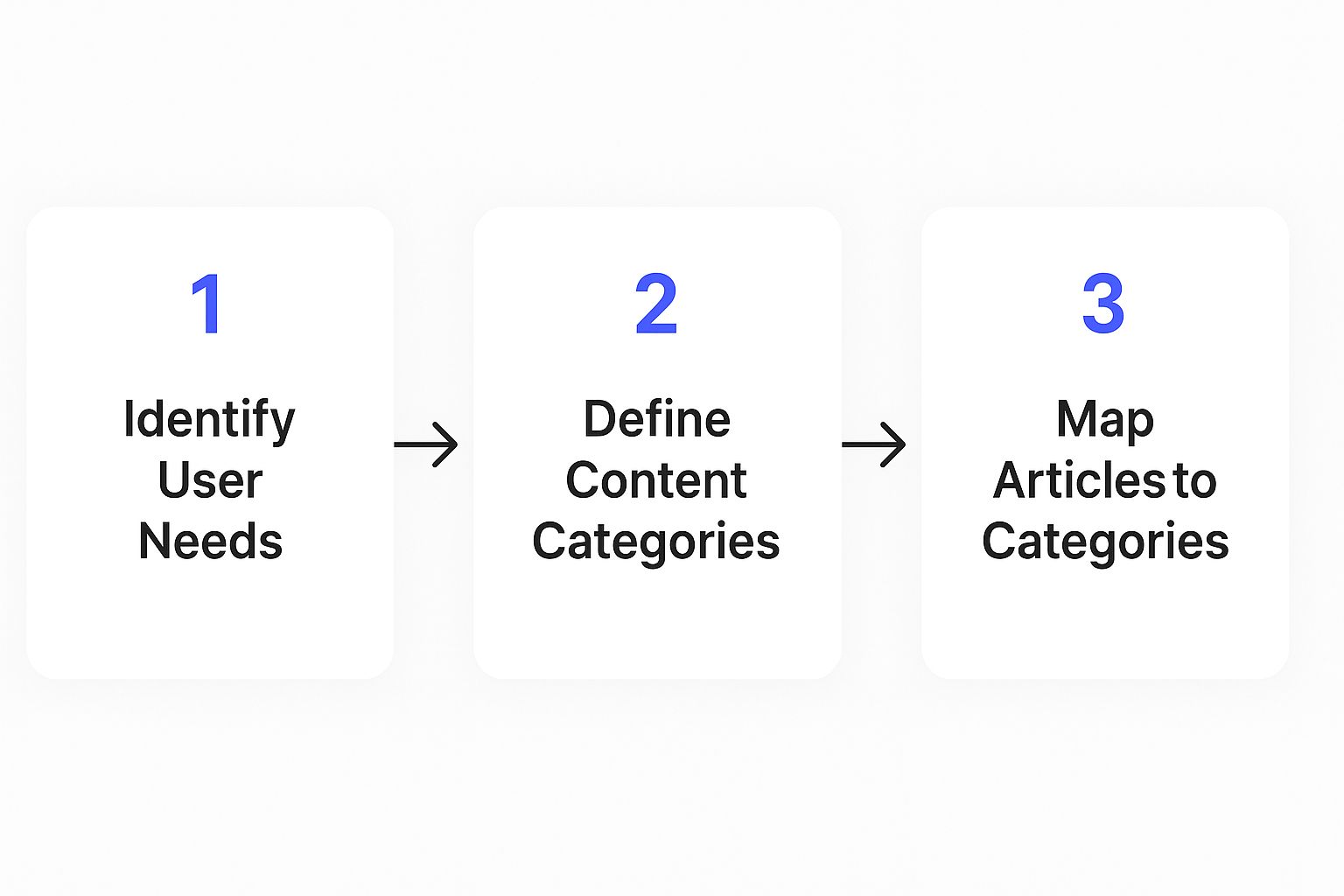How to Create a Knowledge Base That Actually Works
Learn how to create a knowledge base with our practical guide. Get tips on planning, writing, and selecting software to build a useful resource.

Want to create a knowledge base for your company? Maybe you're looking to organize all that company knowledge scattered across email threads, Slack channels, and random documents. The idea is to turn it all into a single, reliable source for your customers and your team.
Why a Knowledge Base Is a Valuable Business Asset

Before writing any articles, it helps to know what problem a knowledge base solves. It's less like a digital filing cabinet and more like a central hub for your organization. For customers, it’s a self-help portal. For employees, it’s an information center.
The goal is to prevent important details from getting lost. By centralizing information, you close knowledge gaps and make sure everyone is working from the same playbook.
The Real-World Impact on Your Business
A good knowledge base solves some common business headaches. For your customer-facing teams, it's a helpful deflection tool. You let users find their own answers, which means fewer repetitive support tickets in your inbox. This frees up your agents to focus on the bigger issues that need a human touch.
Internally, it’s a big productivity booster. New hires can get up to speed much faster when they have a structured library of processes, policies, and how-to guides. That consistency becomes a huge advantage as you grow, helping both customer service and internal operations run smoothly.
A centralized knowledge hub means that every team member, from a new hire to a seasoned veteran, has access to the same accurate information. This consistency is the backbone of scalable customer service and efficient internal operations.
The demand for these solutions is growing. The knowledge base software market was valued at USD 1.43 billion and is projected to hit USD 4.56 billion by 2033, growing at a rate of 14.2%. This growth isn't random; it shows how important centralized knowledge has become for businesses that want to be more efficient. You can learn more about these market projections and what’s driving this shift.
Ultimately, building a knowledge base is an investment in clarity. It creates a more self-sufficient customer base and a smarter, more productive team.
Laying the Groundwork for Your Knowledge Base

A great knowledge base is built on a solid plan. Many teams jump straight into writing articles, only to end up with a messy, unused resource because they skipped the planning phase. Before you write a single word, you need to figure out what your audience actually needs.
For a customer-facing knowledge base, start by digging into your support tickets. They are a goldmine of information, showing you the exact questions and pain points that come up repeatedly.
Your front-line teams, like customer support, sales, and success, are your best source of information. They know what confuses customers, what frustrates them, and what stops them. Ask them what information would make the biggest difference in their day-to-day conversations.
Structuring Your Internal Knowledge
Building an internal knowledge base follows a similar path, but with an inward focus. The goal is to map out the information that keeps your company running smoothly. I suggest starting with a simple question: what does a new hire absolutely need to know in their first week?
That usually covers things like:
- Onboarding materials, including checklists, team directories, and guides to company tools.
- Standard Operating Procedures (SOPs) that outline key workflows for different departments.
- Training documents covering your products, services, and internal processes.
Mapping this out gives new employees a clear path and provides a reliable information source for everyone else. If you want to go deeper on this, there's a complete guide to building a knowledge base that covers these steps in more detail.
Once you have a list of topics, you have to organize them logically. Poor organization is one of the top reasons people give up on a knowledge base. Group related articles into intuitive categories and subcategories.
Think like a user who knows nothing about your internal structure. A good category is something like "Billing and Invoices" or "Product Feature Guides," not "Q3 Marketing Initiatives." The simpler the structure, the more people will use it.
A clear structure keeps users from getting lost and helps them find answers fast. Don't skip this step; it’s the foundation for everything else.
Creating a Simple Style Guide
Finally, put together a simple content style guide. This isn't about being overly rigid; it's about creating a consistent, professional experience. When every article has a similar tone, voice, and format, the entire knowledge base feels more trustworthy and is easier to use.
Your style guide only needs to cover a few key areas:
- Tone of Voice: Are you formal and authoritative, or friendly and conversational?
- Formatting: How should headings, lists, and bold text be used?
- Visuals: Are there guidelines for screenshots, GIFs, or videos?
Setting these ground rules upfront saves time later and gets every contributor on the same page from day one. This initial work aligns with the best knowledge management practices that successful companies use.
Choosing the Right Knowledge Base Software
Picking the software to build and manage your knowledge base is a big decision, and it’s easy to get lost in the options. There are simple platforms, AI-driven systems, and everything in between. This part of the guide is about cutting through that noise to focus on what actually matters for your team’s success.
We'll look at the core functions like search, analytics, and integrations that separate a useful tool from one that just adds another layer of work. The goal is to find software that fits your existing workflow, not one that forces you to change how you do things.
Why You Should Probably Go Cloud-Based
For most businesses today, especially those with remote teams or plans to grow, cloud-based software is the only practical choice. These solutions give you the flexibility and scalability you need without the headache of managing your own servers. No dedicated IT team is required.
The data backs this up. Cloud-based deployment already makes up about 65.5% of the knowledge management software market. And it’s not slowing down, with projections showing it will continue to grow at over 20% through 2030. This growth is all about the need for better AI features and secure, on-demand access for distributed teams.
What Features Should You Actually Look For?
Not all knowledge base platforms are the same. Before you commit to one, you need a clear set of criteria to judge them by.
Here are the features I recommend people compare:
- A Search Bar That Actually Works: A knowledge base is useless if people can't find what they're looking for. You need smart search that can process natural language, handle typos, and deliver relevant results quickly.
- An Editor Anyone Can Use: Your team will spend a lot of time creating and updating articles. A clean, intuitive content editor makes this process faster and less of a chore.
- Real Analytics and Reporting: You have to know which articles are helping people, what they’re searching for (and not finding), and where your content gaps are. Good analytics give you these insights so you can make constant improvements.
- Smooth Integration with Your Other Tools: Your knowledge base shouldn’t be an island. It needs to connect easily with the tools you already use, like Slack, your CRM, or help desk software.
If you want a head start, you can explore curated lists of dedicated knowledge base CMS solutions that are built specifically for this purpose.
To help you compare different platforms, I've put together a simple table that focuses on the features that have the biggest impact on usability and long-term success.
Key Features to Compare in Knowledge Base Software
This table isn't complete, but it covers the non-negotiables. A tool that excels in these areas will provide a solid foundation for a knowledge base that people want to use.
A Simple Framework for Making Your Decision
Ultimately, the right choice comes down to your specific needs. The perfect tool for a small startup will be very different from what a large enterprise requires.
Don't get distracted by a long list of fancy features you'll never use. Focus on a tool that excels at the fundamentals and solves the specific problems your team is facing today.
Before you start looking at software, it’s a good idea to map out your content structure. The image below shows a simple workflow for how to think about organizing your information.

This process of identifying what users need, defining clear categories, and mapping out articles is the real foundation of a useful knowledge base. Once you have this structure in mind, you'll be in a much better position to evaluate different knowledge base management systems and see which one best supports your content plan.
Writing Articles People Will Actually Read

Here’s a hard truth: the best knowledge base software is useless if the articles are dense or confusing. The content is what truly matters. Your goal is simple: write articles that solve problems quickly and clearly, letting users find what they need and get back to their day.
This means you need to break down complex topics into simple, digestible pieces. Think less like a technical writer and more like a helpful guide leading someone through a single, focused task. Every article should have one clear purpose, whether it's answering a common question or walking a user through a process.
Structure for Scannability
Let's be honest, people rarely read knowledge base articles from top to bottom. They scan. They’re looking for headings, keywords, and visual cues to find the exact answer they need, fast. You have to write and format your content to support this behavior.
Start with short, direct paragraphs. Stick to one main idea per paragraph and use plenty of white space. This makes the text feel less intimidating. Long walls of text are the quickest way to send a frustrated user away.
From there, use clear formatting to make your information stand out:
- Use descriptive headings to break up articles into logical, scannable sections.
- Use bullet points and numbered lists for steps, features, or key takeaways.
- Use bold text sparingly to highlight key terms or actions.
This approach lets users jump straight to the information that’s relevant to their problem. No fluff, no friction.
Answering Questions and Solving Problems
Every article should be written from the user’s point of view. A great way to get into this mindset is to frame your article titles as questions or "how-to" statements. It seems small, but it makes a big difference.
Bad Title: "Billing System Configuration"
Good Title: "How Do I Update My Credit Card Information?"
The second title directly matches what a user is already thinking or typing into a search bar. Inside the article, anticipate their follow-up questions and provide clear, step-by-step instructions. For any process, number the steps and explain each one simply. This structure is a core part of effective documentation best practices.
If a process gets even slightly complicated, don't try to explain it all with words. Visuals are a big help here.
Make Your Content More Visual
Sometimes, the best explanation isn't text at all. Visuals can make instructions much easier to follow and cut down on user error. They bridge the gap between reading and doing.
Consider adding these elements into your articles:
- Screenshots: Use them to show users exactly where to click. Add simple annotations like arrows or boxes to draw attention to the important parts.
- GIFs: Short, looping animations are perfect for demonstrating a quick, multi-step action that would be clumsy to describe in writing.
- Short Videos: For more involved processes, a quick screencast can walk a user through an entire workflow in a minute or two, which is often faster than reading.
By combining clear, scannable writing with helpful visuals, you create content that lets users solve their own problems without needing to contact your support team.
Alright, you've put in the work and built your knowledge base. But let's be honest, the real challenge starts now: getting people to use it and keeping the information from going stale. A great launch is all about adding the knowledge base into your team's workflow and making it the go-to resource for customers.
The launch isn't a single event; it's a promotional strategy. For an external, customer-facing knowledge base, this could be an email blast to your users or adding a link inside your app. If it's for your internal team, you need to weave it directly into their daily routines. Making it the first stop for new hires is a classic, effective move.
Turning Your Knowledge Base into a Living Resource
A knowledge base that never gets updated is worse than having no knowledge base at all. The goal is to create a living library of information, and that takes a simple, consistent maintenance plan.
You'll need to get into a rhythm of reviewing and improving your content. A quarterly review of all articles is a solid starting point. Of course, some content needs more attention, especially articles tied to product features that are always changing.
The best maintenance plans aren't based on guesswork. They're built on a continuous loop of user feedback and data analysis. Let your users and the numbers tell you what needs fixing, and you'll prevent your valuable resource from becoming obsolete.
Getting feedback doesn't have to be complicated. Just adding a simple "Was this article helpful?" button at the end of each page gives you an immediate pulse on which articles are hitting the mark and which ones are just creating more confusion.
Using Analytics to Guide Your Efforts
Your analytics dashboard is your best friend here. It shows you exactly how people are interacting with your content, taking the guesswork out of your maintenance plan.
Don't get lost in the data. Just focus on a few key metrics to start:
- Most Viewed Articles: These are your greatest hits. Your top priority should be keeping them flawlessly accurate and up-to-date.
- Failed Search Terms: This is a goldmine. It's a list of everything users are looking for but can't find, giving you a ready-made to-do list for new articles.
- Article Ratings: Any article with low ratings is a red flag. It’s an immediate signal that something is unclear, incorrect, or incomplete and needs your attention right away.
This data-driven approach is the heart of modern knowledge management, a field that has grown quickly. The broader knowledge management sector was valued at nearly USD 788 billion and is on track to hit USD 2.99 trillion by 2034. That massive growth shows just how important systematic information management has become. You can dig into these knowledge management market trends to see why so many businesses are making this a priority.
By mixing regular content reviews with sharp insights from your analytics and user feedback, you can make sure your knowledge base stays a trustworthy and effective resource.
Common Questions About Building a Knowledge Base
Even with a solid plan, a few questions always seem to pop up right when you’re ready to get started. Let's look at some of the most common hurdles teams face when they’re building their first knowledge base.
How Do I Know What Topics to Write About First?
The best place to start is right in front of you: your support data. Your support tickets, emails, and live chat logs are a great resource for figuring out what customers are asking most often.
Your support team can help you here. Sit down with them and ask, "What are the top five problems you solve over and over again?" Answering those questions first will deliver the biggest impact right away.
The same idea applies if you're building an internal resource. Just focus on the basics that everyone needs:
- Standard operating procedures (SOPs)
- Onboarding checklists for new hires
- Answers to common IT or HR questions
Should It Be for Internal or External Use First?
This one really comes down to your biggest pain point.
If your support agents are drowning in repetitive questions, a customer-facing (external) knowledge base can provide immediate relief. It lets users find their own answers, which frees up your team and makes for a much better customer experience.
On the other hand, if your internal teams are struggling to find information and onboarding new hires takes forever, an internal knowledge base should be your priority. Fixing internal inefficiencies is often the smartest first move. Many companies build and refine their internal base to standardize information before making any of it public.
How Often Should I Update Articles?
Outdated information is often worse than no information at all, so setting up a regular review schedule is a must. I recommend aiming to review all your content at least quarterly.
Some articles will naturally need more frequent updates. Any content related to your product, for example, should be revised immediately after any feature changes or software updates.
A simple "Was this helpful?" feedback button on each article is a fantastic way to spot content that needs a second look. You should also keep an eye on your analytics to see which articles are most popular or have low ratings. These should always be at the top of your review list to make sure they're accurate and genuinely helpful.
Ready to build a knowledge base that actually works? Chatiant lets you create a powerful, AI-driven assistant trained on your own data. Turn your documents into a smart resource that provides instant, accurate answers for your team and customers.


